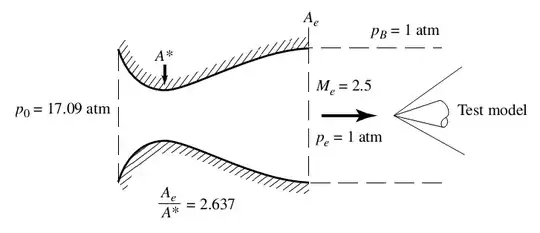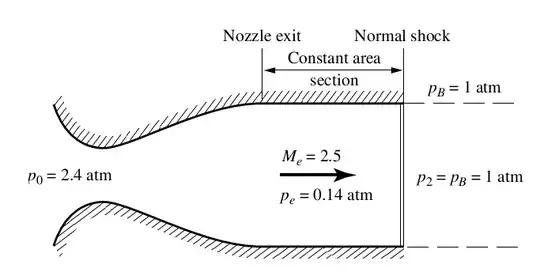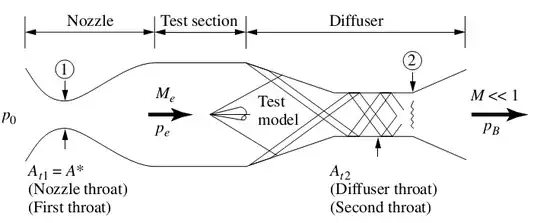I am reading "I am reading "Fundamentals of Aerodynamics" 5th edition, J.D.Anderson. If you have the book, go to chapter 10: Compressible Flow through Nozzles, Diffusers, and Wind Tunnels".
In order to produce Mach 2.5 uniform flow in a laboratory, we can build a wind tunnel like this:
 The back pressure equals atmospheric pressure, the Mach 2.5 flow passes into the surroundings as a free jet. But we need high-pressure air supply at 17.09 atm which can be expensive, so we build this wind tunnel instead:
The back pressure equals atmospheric pressure, the Mach 2.5 flow passes into the surroundings as a free jet. But we need high-pressure air supply at 17.09 atm which can be expensive, so we build this wind tunnel instead:
 A normal shock-wave stand right at the end of the wind tunnel. The reservoir with a pressure of only 2.4 atm which reducing the cost compared with the first wind tunnel.
A normal shock-wave stand right at the end of the wind tunnel. The reservoir with a pressure of only 2.4 atm which reducing the cost compared with the first wind tunnel.
Then the author said: A normal shock is the strongest possible shock, hence creating the largest total pressure loss. If we could replace the normal shock with a weaker shock, the total pressure loss would be less, and the required
reservoir pressure $p_0$ would be less than 2.4 atm. So again, we build this instead:
 with reflected oblique shocks behind the test section.
with reflected oblique shocks behind the test section.
The objective is to have $p_o$ as low as possible and the exit pressure must be equal to atmosperic pressure (= 1 atm). But why is the $p_o$ in case 3 is smaller than $p_o$ in normal shock case ? You might think due to total pressure loss is smaller, but the final total pressures are not the same in two case, so how could we compare the $p_o$.